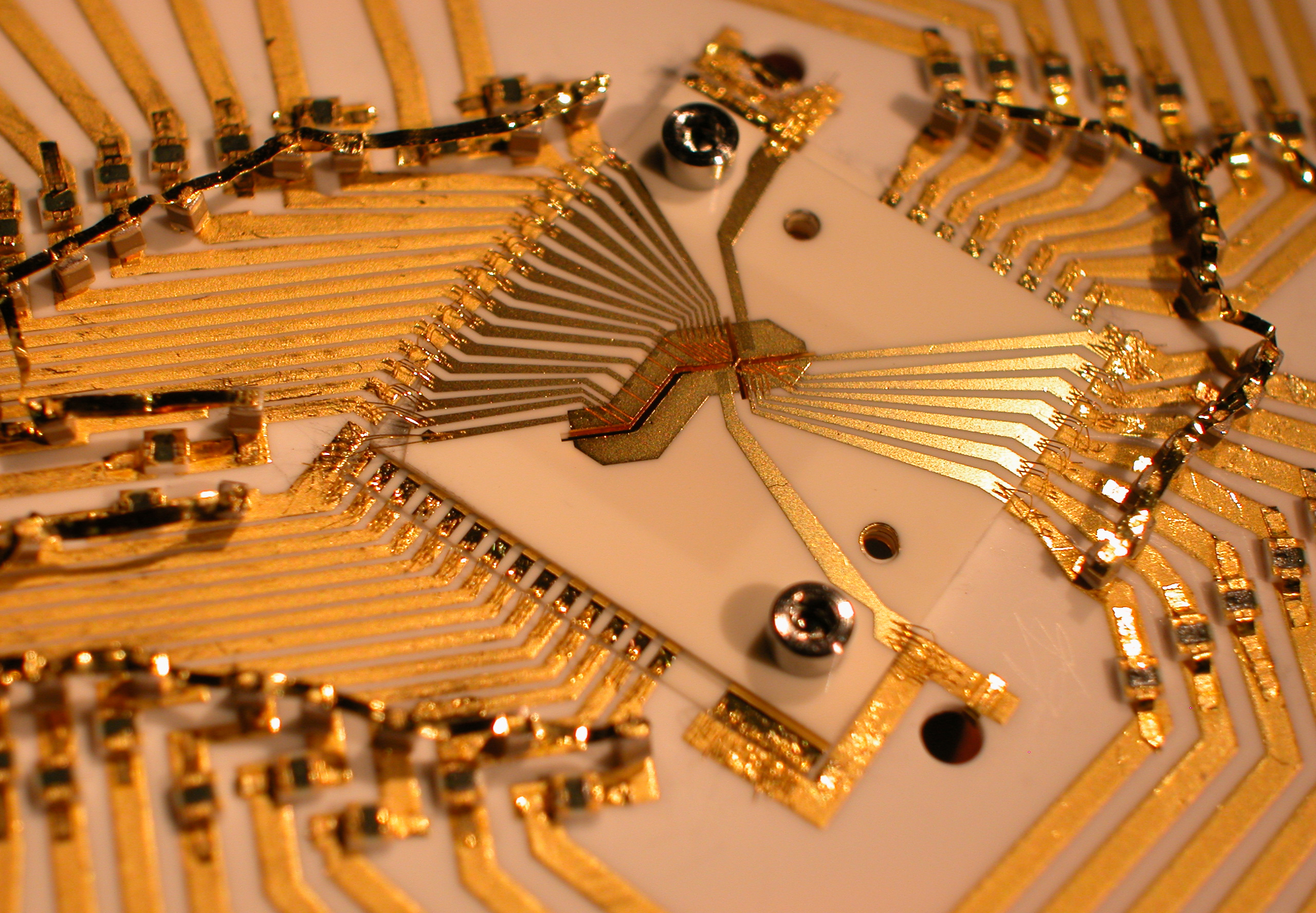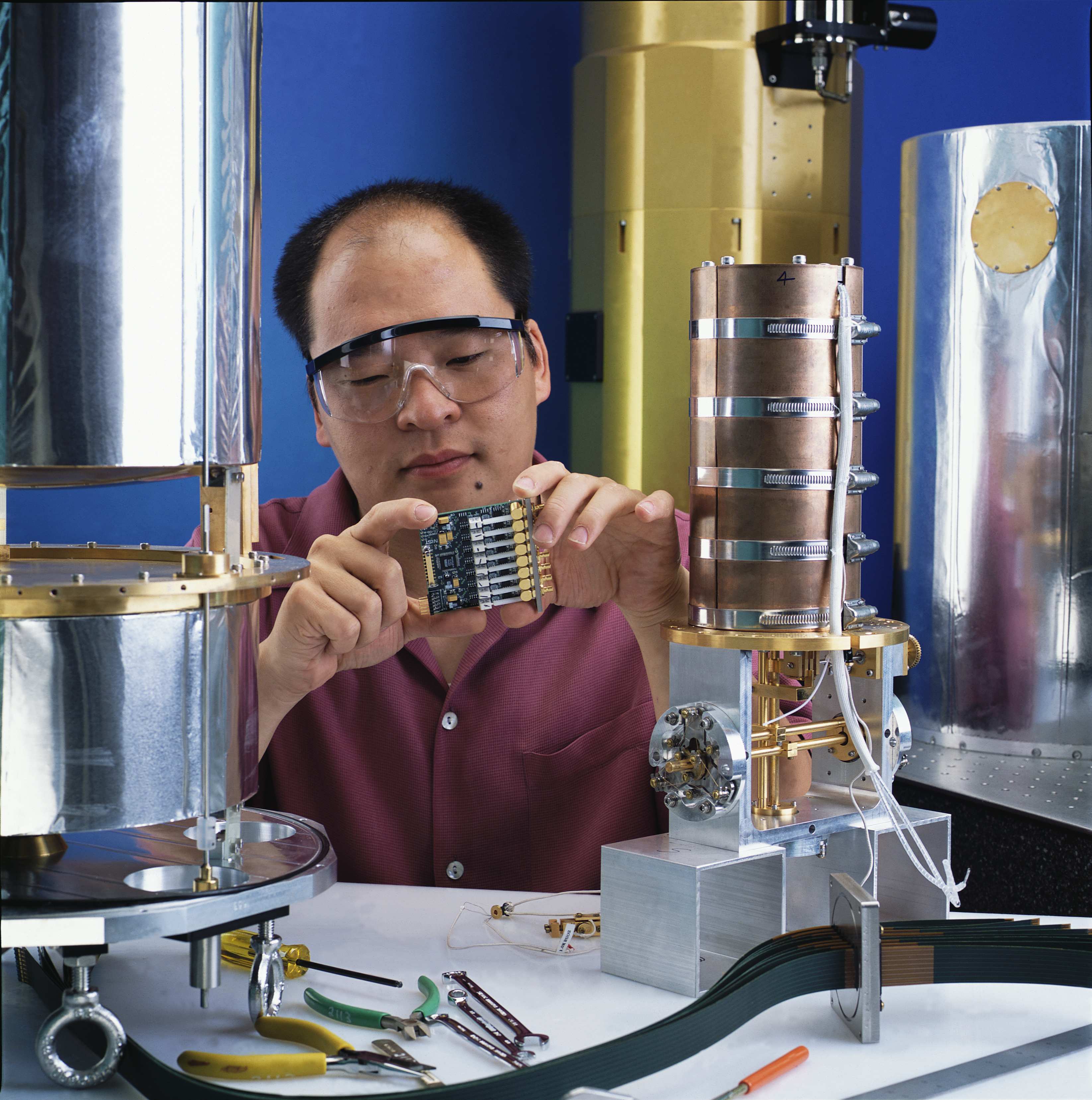The Race to Build a Quantum Computer
Quantum computing remains challenging to implement in practice. The tiniest disturbances can destroy superpositions in qubits. And an entangled quantum system gets more and more fragile as you try to add qubits to it. JQI’s Monroe and his team have managed to entangle 14 ion qubits, but it lasts for only seconds before decoherence afflicts the system. And yet, this is far longer than many of the other experimental systems out there.
The NIST-Boulder group continues to push the envelope in working with ions. They have created a “racetrack” trap for capturing and storing multiple ions that could be used for processing quantum information. They built a quantum processor that can run any computer program that requires only two qubits. A practical quantum computer would require many more qubits, so one idea is to connect many of these two-qubit processors and get them to work together as a full-fledged computer.

Physicists such as those in the NIST ion storage group and Monroe’s group at JQI are making qubits with ions. Other physicists such as NIST Nobel laureate Bill Phillips and Trey Porto are making qubits with neutral atoms. Separate NIST groups led by Sae Woo Nam and Alan Migdall are creating them with photons.

Others, such as Clark and NIST fellow Muhammad Arif, are exploring quantum information with neutrons, neutral particles found in the cores of atoms.
“There’s payoff from this for NIST measurement missions too,” says Arif. “We’ve built a new neutron user facility based on concepts imported from quantum information theory.”
NIST researchers Ray Simmonds, John Teufel and their colleagues are creating them in superconducting electrical circuits that obey quantum rules, and even connecting them to tiny microscopic “quantum” drums that vibrate by releasing tiny packets of energy known as phonons.

Also being created by Konrad Lehnert and his group at JILA, the superconductor-based qubits and quantum drums are made with existing microfabrication technology, could potentially perform operations very quickly, and could be relatively easy to mass-produce and scale up into many-qubit systems.
Companies—from large ones such as Google, IBM, Intel and Microsoft to smaller ones such as Quantum Circuits and IonQ, a startup set up by JQI’s Monroe—also are working to build quantum computers.
One company, D-Wave Systems, has marketed a specialized type of quantum computer, which can be considered a quantum “annealing” machine. Researchers are still trying to determine under what set of conditions it may be more powerful than a classical computer. In chemistry, annealing is a process in which a material such as a glass is first heated and then cooled slowly in order to achieve a desirable property such as greater toughness. In the D-wave computer, thousands of qubits, made of superconducting loops, are first put into a superposition. Researchers then encode the problem they wish to solve in the form of magnetic pulses, which “heat” the qubits to higher-energy states. The qubits then “cool” towards a lower-energy state that represents a solution to the problem. Researchers agree that this quantum annealing machine is not a full-fledged quantum computer, but it may prove more powerful than a classical computer in certain situations.
The race to achieve quantum supremacy is intense.
Google’s John Martinis (a former NIST researcher) has announced that the company aims to soon demonstrate a 49-qubit quantum computer, using superconducting components. IBM has reported building and testing a 50-qubit system, based on superconducting components. (Illustrating the many possible approaches, they and other institutions have also discussed using conventional supercomputers to simulate 56-qubit quantum systems.) At the 2018 CES show in Las Vegas, Intel announced a 49-qubit quantum test chip.

At other institutions, researchers are making qubits with microscopic islands of material known as quantum dots, tiny specks of color that are also popping up in new televisions.
In Japan, researchers have built a system using photons in optical fiber to create what they call a Quantum Neural Network, intended as a specialized quantum computer good at tackling tasks such as the traveling salesman problem. The system was created by an industry-government-academic partnership, including Nippon Telegraph and Telephone, the National Institute of Informatics and the University of Tokyo.
In all, researchers have proposed approximately a dozen kinds of systems that could act as quantum computers, from optical lattices (atoms trapped in webs in light) to topological systems, in which particles would essentially trace patterns in materials to carry out logic operations.
“Every system has its tricks,” says NIST’s Simmonds. “We're all working with the same rules, but just completely different systems. It's more of a universal quantum language.”
Even though researchers are pursuing different ways to make quantum computing technologies, they regularly exchange ideas.
“I think one thing that's really interesting is having different communities constantly learning about each other,” Simmonds says. “We learn a lot from talking to the other groups and seeing how they look at things.”
“If we talk to Dave Wineland’s group, and there's something they do with the trapped ions, thinking about, ‘Can that trick work here?’, that's something that's really complementary,” agrees NIST’s Teufel.
At around the 50-qubit mark, quantum computers may be able to start doing things that ordinary computers can’t. However, Boisvert points out, all existing experimental quantum computer designs lack error correction. “This limits what such devices can reliably do,” Boisvert says. “To scale these up to be able to do large-scale computations—such as factoring—will require error correction, which will require a much larger number of physical qubits and a significantly larger overhead.”
Researchers currently envision quantum computers as being bulky, room-sized devices, like the very first traditional computers in the 20th century. Even though qubits are often tiny, the hardware, such as lasers, needed to control them, can take up a tabletop.
“We won’t have desktop [quantum] computers anytime soon,” says NIST computer scientist Matt Scholl.
“I think it's a question of how the technology will develop over the next 20 or 30 years. But I don't see any reason why the early quantum computers, which will be remote, couldn’t be shrunk to small sizes that you could have in your house,” says JQI’s Monroe.
“Now the question is: why would you want one in your house? And I can't answer that, except to speculate that there will be something coming along, some kind of optimization that everybody will want. They'll want to do it locally. How to get it to work in the right way, I just can't speculate,” he says.

Even if the first quantum computers aren’t portable, modern computing is all about connecting different devices in a network to communicate with one another.
So how, then, would quantum computers exchange information with one another? The ordinary internet has its limits because it can’t transmit the special quantum states needed to preserve quantum information. So, how would you create a quantum internet?
Researchers seem to agree on one thing: photons, or particles of light, will be used to transmit information from one quantum computer to another. In a recent dramatic demonstration, China sent entangled photons from a satellite to the ground 1,200 kilometers (approximately 750 miles) away.
“If you want to communicate quantum information, it’s got to be with photons,” says NIST physicist Sae Woo Nam. “It’s the only way to communicate long distance.”


